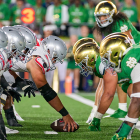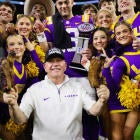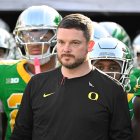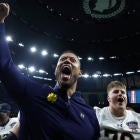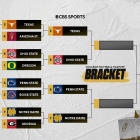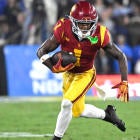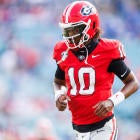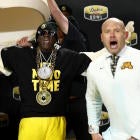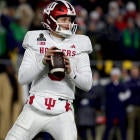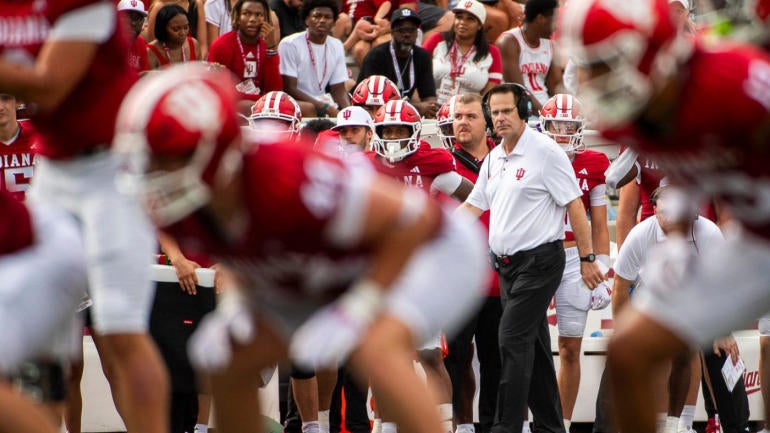
The impact of Indiana's massive transfer flip could be a lot easier to track. The school doesn't release a two-deep to the media. It's a common practice that goes back to the debut of two-platoon football -- specialization on offense and defense -- almost 80 years ago.
In that sense, it's like Jim Harbaugh never left.
These days almost half of the 34 combined schools in the SEC and Big Ten on any given weekend don't post a two-deep chart in their weekly media notes. Apparently, Harbaugh's influence lasted after he left for the NFL. The former Michigan coach famously didn't release a depth chart as a petty piece of gamesmanship to keep the opposition guessing.
They weren't, of course. All they had to do was switch on the film to find out who plays. But even cockeyed traditions from a quirky coach die hard. This one has taken on a new life among college football's top programs.
That hurts the likes of Indiana, which should be promoting the nation's best portal turnaround this season. First-year coach Curt Cignetti signed 31 transfers -- 48 newcomers in all -- in his remake of the typically moribund Hoosiers. Thirty-nine players left. Fourteen of the incoming 31 transfers were from his previous stop at James Madison. Only six came from Power Four programs.
Heck, it's probably the best 2024 turnaround. Period. Full stop. As Brandon Marcello aptly noted in a piece on 247Sports detailing every Big Ten transfer class:
Among all the rebuilds, Indiana might be the most interesting as the talent swap was massive. Cignetti is going all-in on an immediate revamp for a program that was in need of a facelift after the last two years of the Allen era.
With Washington and ESPN's College GameDay coming to town, it's time to reassess the job Cignetti has done, no matter how buried the information.
Year over year, the case can be made that Cignetti's turnaround this year is the third-best in the short history of NIL.
— Lincoln Riley went from 4-8 in 2021 to 12-2 in 2022, his first year at USC relying heavily on transfers.
— Florida State under Mike Norvell went from 5-7 in 2021 to a combined 23-4 in 2022-23, including that ACC title.
Add in Deion Sanders at Colorado and Lane Kiffin at Ole Miss. None of them turned things around so dramatically in their debut seasons. Cignetti is in his first season as an Power Four head coach.
"He didn't understand why Indiana couldn't succeed," said Tyler Harris, executive director of Indiana's collective Hoosier Connect. "All the Indiana fans have scar tissue. The excitement is one thing. Delivering like he has is another."
Since Cignetti arrived, Hoosier Connect has raised six times the money it did a year ago, Harris said.
"The way I've explained him to people who haven't met him … he's kind of like a modern-day Bobby Knight," Harris added. "He's kind of got that edge to him."
Without Knight's borderline personality disorder, it should be noted.
Taken together through eight weeks of the season, Indiana has proven it has the talent and remaining schedule to make it to the College Football Playoff. Ask Indiana alum Mark Cuban.
"He [Cignetti] has come in and done what he said he would do," Cuban told CBS Sports via email. "That's the first step. Now we have to stay healthy."
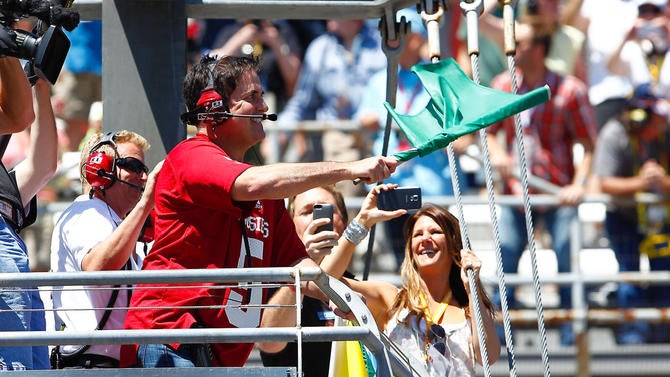
It takes some further research to determine the "why" of Indiana's turnaround. Fourteen of those 27 transfers have started at least one game. As you will see below, transfers lead the Hoosiers in passing, receiving, tackles, sacks and tackles for loss.
- Ohio transfer QB Kurtis Rourke has been the tip of the spear, leading the Big Ten in pass efficiency, accuracy and yards per attempt. His 15 touchdown passes are tied for the team lead. Rourke -- a former MAC offensive player of the year -- will miss the Washington game with a thumb injury.
- JMU transfer Ty Son Lawton is Indiana's second-leading rusher with 393 yards.
- Elijah Sarratt (also JMU) leads the Hoosiers in receptions and receiving yards. Myles Price (Texas Tech) is third on that list.
- Starting tight end Zach Horton (JMU) has 13 catches in seven games.
- Linebacker Aiden Fisher (JMU) leads the Hoosiers in tackles and is tied for third in the Big Ten (66).
- Mikail Kamara (JMU) leads in sacks (6) and tackles for loss (8.5).
- Defensive backs D'Angelo Ponds (JMU) and Shawn Asbury II (Old Dominion) have combined for 72 tackles.
- Long snapper Mark Langston (Georgia Southern) has held the job since the season began.
That's a lot of transfers to have "hit." It's still too early in the NIL era to determine what a meaningful percentage of contributing players in a transfer class is, but Indiana seems to have gotten its money's worth.
"Indiana has done a remarkable job," said Bud Elliott of CBS Sports' Cover 3 Podcast. "In some ways, they basically created a Sun Belt all-star team, plus a quarterback who was the best in the MAC … But the buy-in and the coaching and the attention to detail have been equally as impressive. Indiana isn't just winning, they're killing teams."
To the point that Indiana is winning games by an average of five touchdowns (35 points). That figure leads the country and reflects the biggest year-over-year improvement in that category in 50 years (net 42.8-point improvement). The Hoosiers were outscored by 7.8 points per game last season.
The Hoosiers have also been incredibly efficient. They have gained 75% of available yards to lead the country. That figure is arrived at by dividing potential yardage to the end zone on any given drive by actual yards gained. The top five on that list include Army, Miami, Louisiana and Ole Miss.
Now the question is whether all of it can be sustained in an era where the portal is likely best used on a year-to-year basis, and not as the foundation of a program (cough, cough, Florida State). Cignetti has 20 commits, though all of them are three-star prospects (Indiana ranks No. 53 in the 247Sports Composite Team Recruiting Rankings). The Hoosiers are working desperately to flip top-100 quarterback Julian Lewis, who would be one of their highest-ranked commits ever.
Cignetti saw money and its potential at Indiana. The school is part of the Big Ten's lucrative media rights deal, the largest in history, that could be paying each school $100 million annually by early next decade.
His ability to turn around programs in a short period of time is well-documented.
"Indiana fans were probably thinking, 'This guy has won everywhere. It's just harder at Indiana,'" Harris said. "He's proved us wrong. Now can he sustain it? I think so."
Indiana also has a chance because it has the second-largest number of living alumni in the country, about 900,000. That translated in NIL. Indiana has the 28th-most generous boosters in a 2023 study by USA Today and the Knight Commission. Donors gave a total of $351 million from 2005-2022, according to the study. That number would have been 10th in the Big Ten accounting for realignment.
Indiana's total athletic revenue is 13th overall. It would be fifth in the 16-team Big Ten. (The latest USA Today figures do not reflect the latest realignment.) Still, that figure of $166 million is not insignificant.
"He's exactly what IU needed," Harris concluded. "An acceptable version of Bobby Knight."








